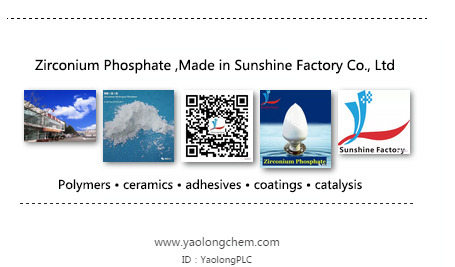Sunshine Factory, Co., Ltd. > Applications > ZrP for PolymerZrP for Polymer
Morphologies and Thermal Properties of Flame-Retardant Polystyrene/a-Zirconium Phosphate Nanocomposites
Abstract
The phosphorus- and nitrogen- containing monomer, acryloxyethyl phenoxy phosphorodiethyl amidate (AEPPA), was synthesized and characterized. Poly (St-co-AEPPA)/a-zirconium phosphate (a-ZrP) nano-composites with different amounts of a-ZrP were then prepared by situ radical bulk copolymerization. X-ray diffraction (XRD) and transmission electron microscopy (TEM) results showed that the a-ZrP layers were exfoliated in the polymer matrix. Improvements in thermal stability and char residues of the copolymer and nanocomposites were observed by thermogravimetric analysis (TGA). The incorporation of AEPPA can reduce the flammability of polystyrene (PS). Moreover, further reductions were observed when a-ZrP was added. The reduction in flammability was attributed to a lower maximum mass loss rate and more char residues of the nanocomposites involved in thermal degradation.
Conclusions
A series of copolymer/a-ZrP nanocomposites was successfully prepared by dispersing a-ZrP in an organic poly (St-co-AEPPA) matrixvia in situ bulk polymerization. The FTIR results confirmed the incorporation of a-ZrP within the copolymer matrix. Their morphologies were further investigated by XRD and TEM. Completely exfoliated nanocomposites were obtained for the sample containing up to 5 wt% a-ZrP relative to the monomers. The DSC measurements showed that the glass transition temperature (Tg) of poly (Stco-AEPPA) was lower than that of pure PS, implying that AEPPA had a plasticizing effect on PS. Meanwhile, the Tg of the poly (Stco-AEPPA) /a-ZrP nanocomposites slightly increased with increasing a-ZrP content. These results may be attributed to the formation of hydrogen bonds between AEPPA and the a-ZrP, which confined the motion of the polymer chain in the a-ZrP galleries. The TGA data showed that the thermal stability and char yields of the virgin copolymer and nanocomposites were significantly enhanced in comparison to pure PS. Furthermore, the thermal stability of the nanocomposites was found to be dependent on the amount of a-ZrP added. With increasing a-ZrP, the temperature of the onset of thermal degradation slightly decreased when 10% weight loss was selected as the point of comparison. With a 50% weight loss as the point of comparison, the variation in the temperature of the onset of thermal degradation was not significant. In the MCC tests, the nanocomposites showed a significant reduction in the heat release capacity (HRC) and total heat release (THR) in comparison to both PS and the flame-retarded copolymer without nanofiller. Based on MCC tests, the flame-retardant mechanism was due to an increase of final char formation and a decreased mass loss rate. This study provided a potential approach for the development of novel halogen-free flame-retardant formulations.


Follow WeChat


